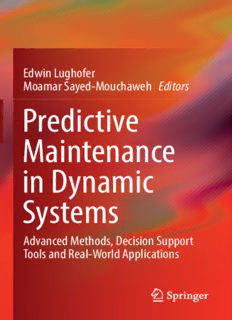
Predictive Maintenance in Dynamic Systems: Advanced Methods, Decision Support Tools and Real-World Applications PDF
Preview Predictive Maintenance in Dynamic Systems: Advanced Methods, Decision Support Tools and Real-World Applications
Edwin Lughofer Moamar Sayed-Mouchaweh Editors Predictive Maintenance in Dynamic Systems Advanced Methods, Decision Support Tools and Real-World Applications Predictive Maintenance in Dynamic Systems Edwin Lughofer • Moamar Sayed-Mouchaweh Editors Predictive Maintenance in Dynamic Systems Advanced Methods, Decision Support Tools and Real-World Applications 123 Editors EdwinLughofer MoamarSayed-Mouchaweh FuzzyLogicLaboratoriumLinz-Hagenberg InstituteMines-TelecomLilleDouai DepartmentofKnowledge-Based Douai,France MathematicalSystems JohannesKeplerUniversityLinz Linz,Austria ISBN978-3-030-05644-5 ISBN978-3-030-05645-2 (eBook) https://doi.org/10.1007/978-3-030-05645-2 LibraryofCongressControlNumber:2019931901 ©SpringerNatureSwitzerlandAG2019 Thisworkissubjecttocopyright.AllrightsarereservedbythePublisher,whetherthewholeorpartof thematerialisconcerned,specificallytherightsoftranslation,reprinting,reuseofillustrations,recitation, broadcasting,reproductiononmicrofilmsorinanyotherphysicalway,andtransmissionorinformation storageandretrieval,electronicadaptation,computersoftware,orbysimilarordissimilarmethodology nowknownorhereafterdeveloped. Theuseofgeneraldescriptivenames,registerednames,trademarks,servicemarks,etc.inthispublication doesnotimply,evenintheabsenceofaspecificstatement,thatsuchnamesareexemptfromtherelevant protectivelawsandregulationsandthereforefreeforgeneraluse. Thepublisher,theauthorsandtheeditorsaresafetoassumethattheadviceandinformationinthisbook arebelievedtobetrueandaccurateatthedateofpublication.Neitherthepublishernortheauthorsor theeditorsgiveawarranty,expressorimplied,withrespecttothematerialcontainedhereinorforany errorsoromissionsthatmayhavebeenmade.Thepublisherremainsneutralwithregardtojurisdictional claimsinpublishedmapsandinstitutionalaffiliations. ThisSpringerimprintispublishedbytheregisteredcompanySpringerNatureSwitzerlandAG. Theregisteredcompanyaddressis:Gewerbestrasse11,6330Cham,Switzerland Toourfamiliesandfriends Preface Duringrecentyears,rapidtechnologicaldevelopmentsandbreakthroughsinvarious industrialautomatizationprocesseswiththesupportofmodernmachines,bigdata storages,andcloudsofcomputersoperatinginparallelledtoasignificantincrease in system complexity and dynamic processes. This makes a manual supervision andmaintenanceofmachines,systemcomponents,andproductionchainsmoreand more unaffordable and thus unrealistic to be conducted in a reasonable amount of timewithreasonableeffortsandcostsforcompanies. Therefore, automated predictive maintenance (APdM) has more and more becomeacentralcornerstoneintoday’sindustrialapplicationsandsystemsranging from online manufacturing rails and production lines through (cyber) security problems and infrastructure management to energy fabrication, maritime systems, and exploitation facilities. This is because APdM addresses not only strategies for the early detection and prediction of significant machine wearing towards componentfailures,degradedperformanceofthesystem,undesiredsituationsand occurrences, or downtrends in product quality but also for taking appropriate actions upon the recognition and prediction of such occasions. Such actions are indispensable for reducing waste, repair, and production costs, or even customer complaints,andthus,inthelongrun,alsoforincreasingtheincomeofcompanies; forguaranteeinghigherqualityofproductionitems,networkfunctionality,software, and user front ends; and finally for reducing the pollution of the environment. In the extreme case of catastrophic system failures, any severe damage to the infrastructure, machine, or system and severe risks for operators working with the systemcanbeavoidedbypredictivemaintenance. The necessity of APdM in theory and practice is reflected in several method- ologicalandapplication-orienteddevelopmentsduringthelast15–20years,where, according to the ISI Web of Knowledge/Science database (Thomson Reuters)— www.webofknowledge.com—the number of publications permanently grew from around100peryeararoundthebeginningofthe2000suptomorethan500peryear around2017,andthenumberofcitationsgrewevenmoreintensively.Furthermore, APdM became an essential component in today’s Industry 4.0 environments and applications, and several objectives with associated calls have been established vii viii Preface during the recent years under the umbrella of the Horizon 2020 Framework Programme“Nanotechnologies,AdvancedMaterials,AdvancedManufacturingand Processing,andBiotechnology.” In a typical predictive maintenance framework, embedded system models play a key role for producing (quality) forecasts, for indicating arising problems and faults at an early stage, or for conducting any deeper diagnosis about upcoming expected (as predicted) anomalous process behaviors in various forms. The high dynamicsintoday’sprocessesorpartsofprocessesoftenhastheeffectthatalready modeled/learneddependenciesbecomeoutdated,whichrequiressystemmodelsto self-adaptovertimeinordertomaintaintheirpredictiveperformanceandtoexpand their “knowledge” and “validation range.” This is hardly considered in the current state of the art of predictive maintenance; therefore, it is a central aspect in this booktoshownewtrendsinthisdirection—infact,mostofthechaptersaredealing with (data-driven) modeling, optimization, and control (MOC) strategies, which possesstheabilitytobetrainableandadaptableontheflybasedonchangingsystem behaviorandnonstationaryenvironmentalinfluences. Apartfromthis,severalnewapplicationsinthecontextofpredictivemaintenance aswellascombinationsofMOCmethodologiestosuccessfullyestablishpredictive maintenance are demonstrated in this book. According to the essential steps in predictivemaintenancesystemsfromearlyanomalyandfaultdetectionduringthe processthroughtheprognosticsofeventuallyarisingproblemsinthe(near)future to their diagnosis and proper reactions on these (through optimization, control for repair,andself-healing),thebookisstructuredintothreemainparts,whereineach ofthem,importantreal-worldsystemsandapplicationscenariosarediscussed: (cid:129) Anomalydetectionandlocalization (cid:129) Prognosticsandforecasting (cid:129) Diagnosis,optimization,andcontrol Furthermore, the first three chapters round off the whole book by discussing important aspects, principal concepts, and requirements and which are of general relevance in predictive maintenance systems and thus can be of significant impor- tanceinanyofthethreemethodologicalsteps(bookparts). Finally,theeditorsareverygratefultoallauthorsandreviewersforcontributing withsubstantialandveryvaluablematerialtomakethisvolumebecomealiveandto setanothercornerstoneintheresearchandpublicationhistoryofpredictivemainte- nancemethodologiesandapplications.Thefirsteditoracknowledgesthesupportby the “LCM—K2 Center for Symbiotic Mechatronics” within the framework of the Austrian COMET-K2 program. We also acknowledge Mary E. James and Menas Donald Kiran for establishing the contract with Springer and supporting us in any organizational aspects. We hope that the volume will be a useful basis for further fruitful investigations and fresh ideas as well as a motivation and inspiration for newcomerstojointhisimportantandstillemergingfieldofresearch. Linz,Austria EdwinLughofer Douai,France MoamarSayed-Mouchaweh October2018 Contents Prologue:PredictiveMaintenanceinDynamicSystems..................... 1 EdwinLughoferandMoamarSayed-Mouchaweh SmartDevicesinProductionSystemMaintenance .......................... 25 Eike Permin, Florian Lindner, Kevin Kostyszyn, Dennis Grunert, KarlLossie,RobertSchmitt,andMartinPlutz On the Relevance of Preprocessing in Predictive Maintenance forDynamicSystems ............................................................ 53 CarlosCernuda PartI AnomalyDetectionandLocalization AContext-SensitiveFrameworkforMiningConceptDriftingData Streams............................................................................ 97 ChamariI.KithulgodaandRusselPears Online Time Series Changes Detection Based on Neuro-Fuzzy Approach.......................................................................... 131 Yevgeniy Bodyanskiy, Artem Dolotov, Dmytro Peleshko, YuriyRashkevych,andOlenaVynokurova Early Fault Detection in Reciprocating Compressor Valves byMeansofVibrationandpVDiagramAnalysis............................ 167 KurtPichler ANewHilbert-HuangTransformTechniqueforFaultDetectionin RollingElementBearings ....................................................... 207 ShazaliOsmanandWilsonWang Comparison of Genetic and Incremental Learning Methods forNeuralNetwork-BasedElectricalMachineFaultDetection ............ 231 DanielLeite ix x Contents EvolvingFuzzyModelforFaultDetectionandFaultIdentification ofDynamicProcesses............................................................ 269 GoranAndonovski,SašoBlažicˇ,andIgorŠkrjanc AnOnlineRFIDLocalizationintheManufacturingShopfloor ............ 287 Andri Ashfahani, Mahardhika Pratama, Edwin Lughofer, Qing Cai, andHuangSheng PartII PrognosticsandForecasting Physical Model-Based Prognostics and Health Monitoring toEnablePredictiveMaintenance.............................................. 313 TiedoTingaandRichardLoendersloot On Prognostic Algorithm Design and Fundamental Precision LimitsinLong-TermPrediction................................................ 355 MarcosE.OrchardandDavidE.Acuña Performance Degradation Monitoring and Quantification: AWastewaterTreatmentPlantCaseStudy................................... 381 Iñigo Lecuona, Rosa Basagoiti, Gorka Urchegui, Luka Eciolaza, UrkoZurutuza,andPeterCraamer Fuzzy Rule-Based Modeling for Interval-Valued Data: AnApplicationtoHighandLowStockPricesForecasting ................. 403 LeandroMacielandRosangelaBallini PartIII Diagnosis,OptimizationandControl Reasoning from First Principles for Self-adaptive andAutonomousSystems....................................................... 427 FranzWotawa DecentralizedModularApproachforFaultDiagnosisofaClass ofHybridDynamicSystems:ApplicationtoaMulticellularConverter... 461 MoamarSayed-Mouchaweh AutomatedProcessOptimizationinManufacturingSystemsBased onStaticandDynamicPredictionModels .................................... 485 EdwinLughofer,Alexandru-CiprianZavoianu,MahardhikaPratama, andThomasRadauer Distributed Chance-Constrained Model Predictive Control for Condition-BasedMaintenancePlanningforRailwayInfrastructures..... 533 Zhou Su, Ali Jamshidi, Alfredo Núñez, Simone Baldi, andBartDeSchutter Index............................................................................... 555 Contributors David E. Acuña Department of Electrical Engineering, Faculty of Mathematical andPhysicalSciences,UniversityofChile,Santiago,Chile Goran Andonovski Faculty of Electrical Engineering, University of Ljubljana, Ljubljana,Slovenia AndriAshfahani NanyangTechnologicalUniversity,Singapore,Singapore SimoneBaldi DelftCenterforSystemsandControl,Delft,TheNetherlands RosangelaBallini InstituteofEconomics,UniversityofCampinas,Campinas,SP, Brazil Rosa Basagoiti Faculty of Engineering, Mondragon Unibertsitatea, Arrasate - Mondragon,Spain SašoBlažicˇ FacultyofElectricalEngineering,UniversityofLjubljana,Ljubljana, Slovenia YevgeniyBodyanskiy KharkivNationalUniversityofRadioElectronics,Kharkiv, Ukraine QingCai NanyangTechnologicalUniversity,Singapore,Singapore CarlosCernuda BCAM-BasqueCenterforAppliedMathematics,Bilbao,Spain FacultyofEngineering(MU-ENG),MondragonUnibertsitatea,Arrasate,Spain PeterCraamer MSIGrupo,Andoain,Spain BartDeSchutter DelftCenterforSystemsandControl,Delft,TheNetherlands Artem Dolotov Kharkiv National University of Radio Electronics, Kharkiv, Ukraine Luka Eciolaza Faculty of Engineering, Mondragon Unibertsitatea, Arrasate - Mondragon,Spain xi
Description: